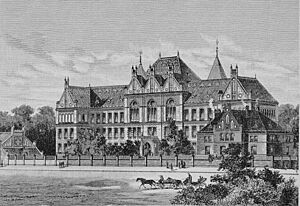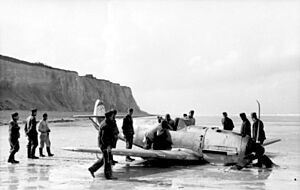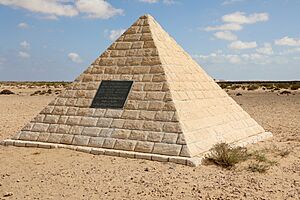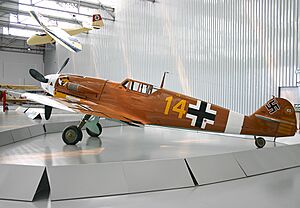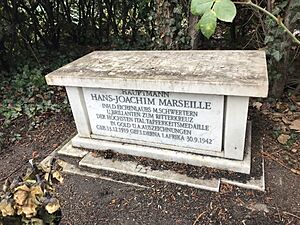Hans-Joachim Marseille facts for kids
Quick facts for kids
Hans-Joachim Marseille
|
|
|---|---|
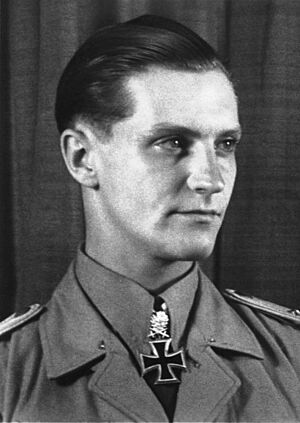
Portrait of Marseille mid-1942
|
|
| Nickname(s) | Stern von Afrika (Star of Africa) to the Germans |
| Born | 13 December 1919 Berlin, Weimar Republic |
| Died | 30 September 1942 (aged 22) near Sidi Abdel Rahman, Egypt |
| Buried | |
| Allegiance | |
| Service/ |
|
| Years of service | 1938–1942 |
| Rank | Hauptmann (Captain) |
| Unit | LG 2, JG 52 and JG 27 |
| Commands held | 3./JG 27 |
| Battles/wars | |
| Awards | |
| Signature | |
Hans-Joachim Marseille (German pronunciation: [hans joˈaχɪm mɑrˈseɪ]; 13 December 1919 – 30 September 1942) was a German Luftwaffe fighter pilot during World War II. He was known for his amazing air battles in North Africa. People called him the "Star of Africa" because he was one of the most successful fighter pilots. Marseille shot down 158 enemy planes, mostly British Commonwealth aircraft, while flying his Messerschmitt Bf 109. No other pilot shot down as many Western Allied planes as he did.
Marseille joined the German Air Force (Luftwaffe) in 1938. At 20, he finished pilot school just in time for the Battle of Britain. He was a charming person, but his lack of discipline caused him to be moved to a different unit, Jagdgeschwader 27 (Fighter Wing 27, JG 27). This unit moved to North Africa in April 1941.
His new commander saw his potential and helped him become a better pilot. On 1 September 1942, Marseille had his best day, shooting down 17 enemy fighters in three flights. This earned him a very high award, the Knight's Cross with Oak Leaves, Swords, and Diamonds. Just 29 days later, Marseille died in a flying accident when his plane's engine failed.
Growing Up and Joining the Air Force
Hans-Joachim "Jochen" Walter Rudolf Siegfried Marseille was born in Berlin on 13 December 1919. His family had French roots. As a child, he was often sick and almost died from the flu. His father was an army officer during World War I.
When Marseille was young, his parents divorced. His mother later remarried. Marseille used his stepfather's name at school for a while, but later went back to using his father's name. He had a difficult relationship with his father.
Marseille also had an older sister, Ingeborg. In December 1941, he learned his sister had died. This sad news affected him deeply.
He went to school in Berlin from 1926 to 1938. Then, from April to September 1938, he worked in the Reich Labour Service.
Marseille joined the Luftwaffe on 7 November 1938. He was an officer candidate and got his basic training in Quedlinburg. He was known for not always following rules, which caused him problems early in his career. He finished his pilot training in Vienna in July 1940. One of his teachers was a famous pilot from World War I, Julius Arigi. Marseille was a very good student.
After training, he was sent to a unit based in Calais, France, to fly missions against Britain.
World War II Air Battles
First Fights Over England
Marseille had his first air battle over England on 24 August 1940. He fought a skilled British pilot for four minutes. Marseille won by climbing high, then diving and firing. The British plane crashed into the English Channel. This was his first victory.
After this, more Allied fighters attacked him. Marseille escaped by diving very fast and flying low over the water. His unit was not happy because he had left his wingman (a partner pilot) to fight alone. This was against the rules of air combat. Marseille reportedly didn't enjoy this victory and found air combat difficult.
On 23 September 1940, Marseille's plane was damaged during a mission over Dover. His engine failed, and he had to bail out over the sea. He floated in the water for three hours before being rescued by a seaplane. He was very tired and cold and had to go to a hospital.
When he returned, his commander was very angry. Marseille had left his leader, Adolf Buhl, who was killed. Because of his actions, Marseille was removed from his unit.
Another story says Marseille once ignored an order to turn back from a fight. He saw an Allied plane attacking his leader, so he broke formation and shot it down. Instead of praise, he got three days of punishment for not following orders. He was also passed over for promotion, which was embarrassing for him.
In October 1940, after seven victories, Marseille was moved to another unit, Jagdgeschwader 52. He crashed or damaged four planes during this time. In December, he was punished again for calling a fellow pilot a "goofy pig." Because of his behavior and his love for American jazz music, he was transferred to Jagdgeschwader 27 on 24 December 1940.
His new commander, Eduard Neumann, said Marseille was "tempestuous, temperamental and unruly." But Neumann also saw that Marseille could be a great pilot. Soon, Jagdgeschwader 27 moved to North Africa.
Arriving in North Africa
Marseille's unit briefly fought in Yugoslavia in April 1941 before moving to Africa. On 20 April, his plane had engine trouble, and he had to land in the desert. He eventually caught up with his squadron.
Marseille scored his first victories in North Africa on 23 and 28 April. However, on 23 April, he was shot down by a French pilot, James Denis. Marseille's plane was hit many times, but he managed to crash-land safely near Tobruk.
Records show James Denis shot down Marseille again on 21 May 1941. Marseille's plane crashed behind German lines near Tobruk. Denis later said he tricked Marseille into overshooting him.
Between these battles, Marseille shot down a British bomber on 28 April. All five men on board died. A Polish soldier saw the attack and described how the bomber crashed into the sea.
Marseille's commander, Neumann, encouraged him to train himself to get better. Marseille's success rate was low at first. He often flew into enemy formations, which meant his plane was often damaged. Neumann grew impatient. But Marseille kept trying. He created his own training plan, both physical and tactical. He improved his awareness, shooting skills, and control of the plane. He developed a unique attack method: instead of chasing planes from behind, he would attack from the side with a quick, angled shot. He practiced this with his friends after missions.
As Marseille started shooting down more planes, he sometimes helped enemy pilots he had downed. On 13 September 1941, he shot down an Australian pilot, Pat Byers. Marseille flew to Byers' airfield and dropped a note to tell the Australians about Byers' condition. He even returned days later to share the sad news of Byers' death. He did this even after his commander warned him not to.
On 24 September 1941, his training paid off. He shot down four South African Air Force planes in one flight. These were his 19th to 23rd victories. By mid-December, he had 25 victories and received the German Cross in Gold. Marseille became known for shooting down many planes in one flight.
The "Star of Africa" Shines
Marseille always worked to improve. He exercised to handle the strong G-forces of air combat. He drank a lot of milk and didn't wear sunglasses, thinking it would improve his eyesight.
Allied pilots often flew in "Lufbery circles" for defense. This meant each plane's tail was covered by the plane behind it, making it hard for an enemy to attack.
Marseille, however, would dive very fast into the middle of these circles. He would make a sharp turn and fire a quick, two-second shot to destroy a plane. His excellent eyesight helped him spot enemies first. He was also very aware of everything happening around him in the air.
In combat, Marseille often worked alone, keeping his wingman far enough away to avoid accidents. He would sometimes slow down his plane a lot, even using landing flaps, to make tighter turns. Other pilots couldn't do this as well. He would dive from above, climb under an enemy, fire as the plane disappeared under his own, then use the dive's speed to climb and repeat.
His success led to promotions. On 1 May 1942, he became an Oberleutnant (First Lieutenant). On 10 June 1942, he became the leader of 3./JG 27.
Marseille once told a friend about his fighting style: "I see myself in the middle of a British swarm, firing from every position and never getting caught. You've got to be able to shoot from any position. Only this way can you develop your own tactics. Attack tactics that the enemy simply cannot guess."
On 13 May 1942, Marseille had a close call. His plane was damaged in a fight with 12 Kittyhawks. He still shot down two planes before safely returning his damaged aircraft to base. These were his 57th and 58th victories.
On 26 May 1942, a big battle started in North Africa. Four days later, on 30 May, Marseille saw his 65th victim, Pilot Officer Graham George Buckland, fall to his death because his parachute didn't open. Marseille drove to the crash site, marked the grave, and collected Buckland's papers. He then flew to Buckland's airfield to deliver a letter of sadness.
Marseille's unique attack method led to many quick victories. On 3 June 1942, he attacked 16 P-40 fighters and shot down six of them, five in just six minutes! This included three enemy aces. These were his 70th to 75th victories. His wingman said Marseille's shots always hit the engine and ended in the cockpit. For this, he received the Knight's Cross with Oak Leaves on 6 June 1942.
Another pilot, Werner Schröer, said Marseille was "the most amazing and ingenious combat pilot I ever saw." He added, "He thought nothing of jumping into a fight outnumbered ten to one, often alone. He violated every cardinal rule of fighter combat."
On 17 June 1942, Marseille reached 100 aerial victories. He was the 11th German pilot to do this. He then went back to Germany for two months' leave. The next day, he received the Knight's Cross with Oak Leaves and Swords.
On 13 August, he met Benito Mussolini in Rome and received Italy's highest military award for bravery.
Marseille returned to combat on 23 August. 1 September 1942 was his most successful day. He claimed 17 Allied planes shot down (victories 105–121). This included eight planes in just 10 minutes! His Italian friends gave him a special car with "Otto" (Italian for "eight") painted on it. This was the most planes shot down by a single pilot from Western Allied air forces in one day.
On 3 September 1942, Marseille claimed six more victories but was hit by fire from a British-Canadian pilot, James Francis Edwards. Marseille became very famous through German propaganda, which showed fighter pilots as superstars. He often signed postcards with his picture.
Three days later, Edwards likely killed Günter Steinhausen, a friend of Marseille. The next day, another close friend, Hans-Arnold Stahlschmidt, went missing. These losses affected Marseille deeply. He became quieter and sadder in his last weeks. The stress of combat also caused him to sleepwalk.
Marseille continued to score many victories in September, including seven on 15 September (victories 145–151). He couldn't fly between 16 and 25 September because he fractured his arm in a forced landing. On 26 September, after his last combat, Marseille was very tired. He had fought a Spitfire pilot in a tough dogfight. He said, "That was the toughest adversary I have ever had. His turns were fabulous... I thought it would be my last fight."
Marseille's Final Flight
On 26 September 1942, Marseille flew a new type of plane, the Bf 109 G-2/trop. He had avoided using these planes because their engines often failed. But he was ordered to use them. One of these planes, WK-Nr. 14256, was the last one he flew.
For the next three days, Marseille's unit rested. On 28 September, he was invited to Berlin to meet Adolf Hitler, but Marseille refused. He said he was needed at the front and wanted to save his leave for Christmas to marry his fiancée.
On 30 September 1942, Captain Marseille was leading his unit on a mission. While returning to base, the cockpit of his new Messerschmitt Bf 109 G-2/trop filled with smoke. He couldn't see and was guided back to German lines by his wingmen. When they reached friendly territory, Marseille decided to bail out. His last words to his friends were, "I've got to get out now, I can't stand it any longer."
Marseille rolled his plane onto its back, which was the normal way to bail out. But because of the smoke and being a little confused, he didn't realize the plane was diving very steeply and going very fast. He got out of the cockpit but was hit by the air rushing past the plane. He died instantly when he hit the tail of his aircraft. His parachute did not open.
His funeral was held on 1 October 1942 in Derna, Libya. His commander, Eduard Neumann, gave a speech.
An investigation found that the crash was caused by engine damage. A part broke off and caused an oil leak, which caught fire. Human error or sabotage were ruled out.
Marseille's death greatly affected his unit. The German fighter units were already outnumbered by the Allies. The loss of Marseille and two other friends just weeks before made morale very low. Some historians say that because Marseille was so successful, other pilots in his unit relied on him too much. They didn't get to score many victories themselves. So, when he died, the unit was not ready for it.
It's not clear how much Allied pilots knew about Marseille. Some said he was very skilled and deadly. Others believe that most Allied pilots probably didn't know him well.
Marseille's Character and Views
Some historians have looked into Marseille's personality and his feelings about the Nazi government. Some say he was "openly anti-Nazi." When Marseille first met Hitler in 1942, he didn't like him. He even said some negative things about Hitler and the Nazi Party, which upset Hitler.
At a party hosted by Willy Messerschmitt, the designer of his plane, Marseille played American Jazz music on the piano. This was in front of Hitler and other important Nazi leaders. Hitler reportedly left the room, as jazz was not approved by the Nazis.
Later, Marseille heard a conversation about crimes against Jewish people. He asked his friends if they knew what was happening to Jews. He had tried to ask about Jewish people who had disappeared from his own neighborhood. But people either changed the subject or turned away. After this, Marseille never spoke about it with his comrades again.
Marseille's friendship with a South African prisoner of war named Corporal Mathew Letuku, nicknamed Mathias, also shows his character. Marseille befriended Mathias and took him as a personal helper, instead of letting him go to a prisoner-of-war camp. They became very close. Marseille made sure that if anything happened to him, Mathias would stay with the unit. Mathias remained with JG 27 until the end of the war and even attended reunions later. This friendship was against Nazi rules about race.
Historians also note Marseille's love for Cuban rumba, jazz, and swing music. They believe this was another way he quietly resisted Nazi ideas.
Remembering Marseille
- Italian engineers built a pyramid at the site where Marseille died, but it fell apart over time. In 1989, Eduard Neumann and other former JG 27 members, with the help of the Egyptian government, built a new pyramid.
- After Marseille's death, his unit, 3./JG 27, was renamed the "Marseille Staffel."
- His grave has one word: Undefeated. His remains were moved from Derna to a German war cemetery in Tobruk.
- The tail rudder of one of his planes, showing 158 victory marks, is now on display at the Luftwaffenmuseum der Bundeswehr (German Air Force Museum) in Berlin.
Marseille's Career Summary
Air Victories and Claims
Marseille joined his first combat unit on 10 August 1940. He flew his first mission on 13 August 1940 and claimed his first victory on 24 August 1940. In just over two years, he claimed 158 aerial victories in 382 combat missions.
Some historians and Allied veterans have questioned how accurate Marseille's claims were, especially for 1 and 15 September 1942. One historian, Robert Tate, found that about 65–70% of Marseille's claims could be confirmed. This means about 50 of his claims might not have been actual kills. However, Tate also found similar rates for other top Allied pilots.
On 1 September 1942, Marseille claimed 17 planes. Allied records for many years did not show any losses on that day. But later research by Tate, Christopher Shores, and Hans Ring found that the Allies did lose more than 17 planes in the area Marseille was fighting.
Historians also noted that Marseille and other Axis pilots shot down very few bombers in North Africa. Allied bombers were causing a lot of damage to German ground units. Some point out that shooting down fighters, rather than bombers, had less military value.
Awards and Honors
- 1 February 1940: Aviator badge
- 9 September 1940: Iron Cross Second Class (for two air victories)
- 17 September 1940: Iron Cross First Class (for fourth air victory)
- 3 November 1941: Honorary Cup of the Luftwaffe
- 24 November 1941: German Cross in Gold (first German pilot in Africa to get this, for 25 victories)
- 22 February 1942: Knight's Cross of the Luftwaffe (for 46 victories)
- 6 June 1942: Oak Leaves to the Knight's Cross (for 75 victories)
- 18 June 1942: Swords to the Knight's Cross with Oak Leaves (presented by Hitler)
- August 1942: Combined Pilots-Observation Badge in Gold with Diamonds
- August 1942: Gold Medal of Military Valour (from Benito Mussolini in Rome)
- 3 September 1942: Diamonds to the Knight's Cross with Oak Leaves and Swords (only the fourth German serviceman to receive this)
- 16 September 1942: Promoted to Captain (youngest captain in the Luftwaffe)
- 30 November 1962: His family received an honorary pension from the Italian Minister of Defence.
- Front Flying Clasp of the Luftwaffe in Gold with Pennant "300"
Ranks Held
Marseille joined the military on 7 November 1938.
- 7 November 1938: Flieger (Airman)
- 13 March 1939: Fahnenjunker (Officer Cadet)
- 1 May 1939: Fahnenjunker-Gefreiter
- 1 July 1939: Fahnenjunker-Unteroffizier
- 1 November 1939: Fähnrich (Officer Candidate)
- 1 March 1941: Oberfähnrich
- 16 June 1941: Leutnant (Second Lieutenant)
- 8 May 1942: Oberleutnant (First Lieutenant)
- 19 September 1942: Hauptmann (Captain)
See also
 In Spanish: Hans-Joachim Marseille para niños
In Spanish: Hans-Joachim Marseille para niños


